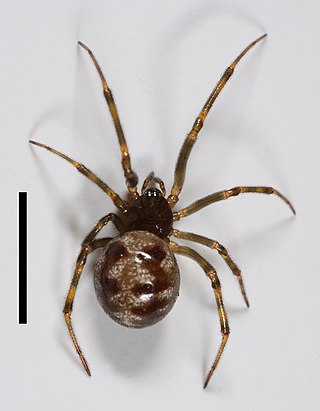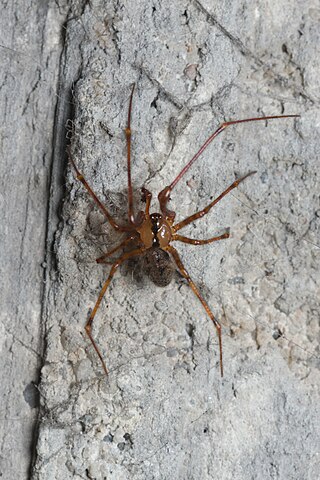
Theridiidae, also known as the tangle-web spiders, cobweb spiders and comb-footed spiders, is a large family of araneomorph spiders first described by Carl Jakob Sundevall in 1833. This diverse, globally distributed family includes over 3,000 species in 124 genera, and is the most common arthropod found in human dwellings throughout the world.

The spider genus Steatoda, in the family Theridiidae, includes about 120 recognized species, distributed around the world. One common name is cupboard spider, for many species build their webs in dark, sheltered, undisturbed places around the house or garden, in sheds and garages, under garden, in compost bins, and the like. Signs of the cupboard spider include small white spots of spider droppings, like small splashes of paint, on the floor underneath the web.

Steatoda grossa, commonly known as the cupboard spider, the dark comb-footed spider, the brown house spider, or the false widow or false black widow, is a common species of spider in the genus Steatoda.

The triangulate cobweb spider is a common spider in the genus Steatoda. It is well known for the triangle-shaped pattern on the dorsal side of its abdomen.

Steatoda nobilis is a spider in the genus Steatoda, known in the United Kingdom as the noble false widow, as it superficially resembles and is frequently mistaken for the black widow and other spiders in the genus Latrodectus. It is often referred to as thefalse widow, although "false widow" is a more general term applied to a wider group of species with this resemblance.[a] It is a moderately medically significant spider, with most bites resulting in symptoms similar to a bee or wasp sting. Some bites may cause more significant harm, partly due to pathogenic bacteria from the spiders.

Steatoda capensis is a spider originating from South Africa. Its common names include the black cobweb spider, brown house spider, cupboard spider and due to its similarities to the katipō spider it is commonly known as the false katipō in New Zealand. Common throughout Southern Africa, it has been introduced into other countries and is now present in Australia and throughout New Zealand. It is a small spider, usually an all-over shiny black. It may have a small bright red, orange, or yellow patch near the tip of the abdomen along with a crescent shaped band near the front of the abdomen.

Steatoda bipunctata is a species of cob-web spider, of the genus Steatoda, in the family Theridiidae.

Platnickina is a genus of comb-footed spiders that was first described by A. Ö. Koçak & M. Kemal in 2008.

Hentziectypus is a genus of comb-footed spiders that was first described by Allan Frost Archer in 1946. Originally placed with Theridion, it was moved to Achaearanea in 1955, and to its own genus in 2008. These spiders most resemble members of Cryptachaea, but are distinguished by a median apophysis that is broadly attached to the tegulum. Spiders of Parasteatoda have a median apophysis attached to the embolus, while those of Achaearanea have a hooked paracymbium on the pedipalps of males.

Steatoda borealis is a species of cobweb spider in the family Theridiidae. It is found in the United States and Canada.
Crustulina altera is a species of cobweb spider in the family Theridiidae. It is found in the United States.
Steatoda grandis is a species of cobweb spider in the family Theridiidae. It is found in the United States.

Steatoda albomaculata is a species of cobweb spider in the family Theridiidae. It is found in North America, Europe and Russia, North Africa, Israel, Kazakhstan, Iran, Central Asia, China, Korea, Japan.

Crustulina sticta is a species of cobweb spider in the family Theridiidae. It is found in North America, Europe, Turkey, Caucasus, a range from Russia, Kazakhstan, China, Korea, and Japan.
Steatoda punctulata is a species of cobweb spider in the family Theridiidae. It is found in the United States and Mexico.
Steatoda palomara is a species of cobweb spider in the family Theridiidae. It is found in the United States.
Steatoda hespera is a species of cobweb spider in the family Theridiidae. It is found in the United States and Canada.

Steatoda erigoniformis is a species of cobweb spider in the family Theridiidae. It is found in a range from the East Mediterranean to the Near East, Caucasus, China, Korea, Japan, and has been introduced into the Caribbean.

Steatoda paykulliana is a species of false black widow spider in the tangle-web spiders family, native to the Mediterranean countries, Southern Europe and Western Asia. The species is named in honor of the Swedish naturalist Gustaf von Paykull (1757–1826).

Nesticus cellulanus, also known as the cavity spider or comb-footed cellar spider, is a species of scaffold web spider. It is found throughout Europe and Turkey, and has been introduced to North America.














